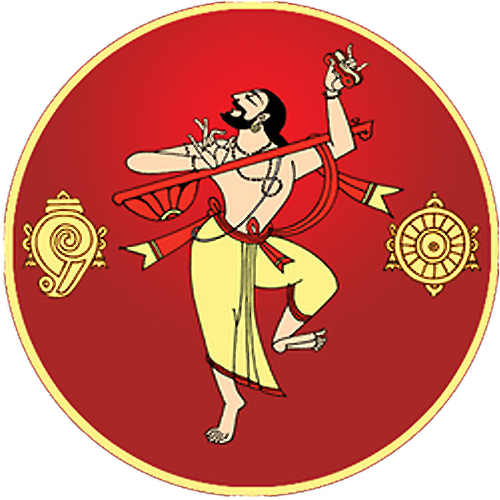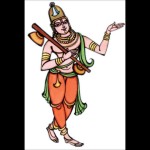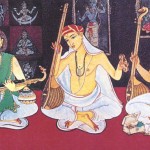The following Post is part of a Series composed by Ashok Madhav garu, vaggeyakara.
The Telugus have a long tradition of musical heritage for several centuries. One can see the valuable contributions made by Tallapaka composers-the foremost being Annamacharya (1408-1503) among them. Other celebrated composers were Bhadrachala Ramadasu (1622-1680), Narayana Teertha (1650-1745) and Kshetragna (1600-1680). They have been instrumental in bringing the philosophical concepts of Vedas and Upanishads to the common man in the form of simple compositions infused with bhakti as devotion to the Lord. Their compositions written in Telugu and set in familiar ragas are in the form of padyams or keerthanas, which have been popular in almost all villages and towns in Andhra . A significant feature in Andhra was the absence of patronage or support given by kings to these musician-composers (some things haven’t changed…). The Tanjavur Maharajahs in Tamil Nadu, Mysore Maharajahs in Karnataka and the Royalty of Trivandrum in Kerala nurtured growth of fine arts. It was only in the last 250 years or so, there has been concerted creative activities happening in Andhra.
Tumu Narasimha dasa (1753-1820), a contemporary of Thyagaraja, was a noted composer, who lived in Bhadrachalam on the banks of Godavari river. He composed about 500 keerthanas both in Sanskrit and Telugu. It is said that Narasimha dasa traveled all the way down south to meet Thyagaraja in Tiruvaiyaru in 1801. He was awed to see the enormous influence the bard of Tiruvaiyaru had transmitted to his disciples through his bhakti oriented music. He was inspired to compose a few padyams and keerthanas in praise of Thyagaraja. “Bhajana chese vidamu” in Sourashtra raga and “Rama namamrutame neeku” in Madhayamavati are a couple that can be mentioned.

Munipalle Subramanya Kavi (1730-1780) from the village of Munipalle in Krishna district was one of the pioneers in classical music. He was versatile in Telugu and Sanskrit. He received royal patronage from the ruler of Kalahasti, Damerla Timmappa Nayaka. Subramanya Kavi was supposed to have composed more than 100 keerthanas, out of which 60 or so are available with notations. These are retrieved largely through the efforts of Andhra Ganakala Parishad, Rajamahendravaram .He is the author of “Adhyatma Ramayana Sankeerthanalu”.
Venkatadri Swami (1807- 1877) was from Alluru, in Krishna district was another gifted vaggeyakara. He was inspired into bhakti music at a young age. He traveled to various pilgrim centers like Bhadrachalam, Kancheepuram, Srirangam etc. Just like Thyagaraja, Venkatadri Swami too composed kritis on the presiding deities of the temples he visited. His compositions exude bhava and bhakti, some of which are being rendered even to the present time.” Kasturi Rangayya” in Anandabhairavi and “Mrokkeda raara” in Shankarabharanam are fine examples of his compositions.
Narumanchi Janakiramaiah (1823-1890) hailed from Tenali, Guntur district. As a young boy he was determined to learn music from none other than Saint Thyagaraja himself. Without his family’s knowledge, he took off to Tiruvaiyaru walking all the way there, just to meet the great composer and get the benefit of his musical genius. Thyagaraja was already in his 60’s and getting a little frail. He suggested that Janakiramaiah get his musical education from Veena Kuppaiyer, who was a senior disciple of Thyagaraja. Janakiramaiah spent 15 odd years in Tiruvaiyaru getting trained before returning home. Janakiramaiah was the first musician to introduce the Tanjavur style of Carnatic Music to Andhra. His music was full of raga and bhava. However, he was better known as a music teacher than as a composer .
Mahakavi Dasa Sri Ramulu (1846-1908) from Alluru in Krishna district was considered to be a multi-faceted intellect. He was a man of letters, wrote commentaries on Devi Bhagavatam, Prabandhas etc. He composed several kritis, swarajathis, javalis and tillanas. Some of his compositions are being used in Bharatanatyam and Kuchipudi dance styles and also in music concerts too. His contributions to music and dance have been outstanding. “Vanitaro e vane” (javali) in Anandabhairavi is one of his popular compositions.
Adibatla Narayana Dasa ( 1864-1945) was a self taught genius and a well known Harikatha artiste. Primarily for his Katha-kaalashepams, he composed several padyams and keerthanas, which caught the attention of music lovers, not only for their literary beauty but also for their musical grandeur. He is considered the father of Katha-kaalashepam in Telugu desham. He had an uncanny ability to compose verses in Telugu and Sanskrit extempore.
Prayaga Rangadasa (Gudimellarika) (b.1859) was well reputed for his rendition of ‘Adhyatma Ramayana Kirtanas’, Narayana Teertha’s ashtapadis and tarangams. He was a good exponent of harikathas. He was a composer of merit, whose compositions had special appeal for every one. Two of his compositions mentioned here are:
“Rama rama enarada” in Sindhubhairavi and “ Ramudu udhbhavinchinadu” in Chenjuti.
Tumarada Sangameshwara Sastri (1874-1931) from Bobbili was known primarily as a veena vidwan. He traveled to Madras, Tanjavur and other centers of music in Tamil
nadu and Karnataka. He was fascinated by the music of Veena Seshanna of Mysore. He has composed several tana varnas and kritis.
Kocherlakota Ramaraju (1878-1950) from Thaatipaka, a small village in the East Godavari district has authored ‘Srirama Keerthana Karnamrutham’ and has composed
varnas, kritis and swarajatis. His three compositions are “Daya radu naapai” in Todi, “Dayachudamani koridi” in Bilahari and “Balakrishna mohana” (Swarajati) in Mohana are well known.
Hari Nagabhushanam (1884-1959), of Machilipatnam, was a practising lawyer, a violinist and a composer of kritis. While studying law in Madras in his youth, he had ample opportunities to listen to the violin stalwarts like Tirukkodikaval Krishan Iyer, Tiruchi Govindaswami Pillai and others. He has composed several kritis. His kriti, “Madhava priye mahima”- Madhavamanohari is well structured.
Rallapalli Ananthakrishna Sharma (b.1893 ) from Anantapur was a well known scholar in both Telugu and Sanskrit and a composer of keerthanas. He was a disciple of Bidaram Krishnappa of Mysore. His name is more commonly associated with Vetturi Prabhakara Sastri in bringing out the keerthanas of Annamacharya. These keerthanas, which had been inscribed on copper plates, were unearthed in the compound of Tirupati Devasthanam. Sharma has tuned several Annamacharya keerthanas. Two of the popular ones that come to mind are: “Alarulu kuriyaga”-Sankarabharanam and “Brahma kadigina” – Mukhari. He was honoured by the Music Academy with the title ‘Sangita Kalanidhi’ in 1974.
It is interesting that a few kritis of Tirupati Vidyala Narayanaswamy Naidu’s (b.1897) have become popular in other regions too. His repertoire include kritis and javalis. The following two kritis –“Ika naina na” -in Pushpalatika and “ Paraakela Saraswati” in Nattakuranji are rendered by musicians of Tamil Nadu also.
These are the notable vaggeyakaras of the Telugus, before 1900. Part II of the Series will focus on Carnatic Composers of Andhra after 1900.

The author of this post, Ashok Madhav garu, is an accomplished Carnatic composer who has composed in all 72 Melakarta ragas. We thank him for his kind permission to reprint this piece, a version of which was originally published at at carnaticcorner.
Disclaimer: This article represents the opinions of the Author, and should not be considered a reflection of the views of the Andhra Cultural Portal. The Author is responsible for ensuring the factual veracity of the content, herein.






